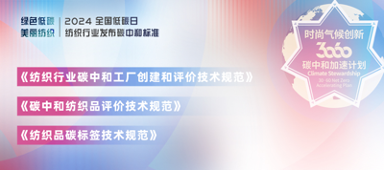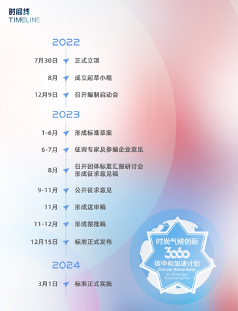National Low Carbon Day | The textile industry has released three carbon neutrality group standards
On May 15, on the occasion of the National Low Carbon Day, the China National Textile and Apparel Council officially issued three group standards: "Technical Specifications for the Creation and Evaluation of Carbon Neutral Factories in the Textile Industry", "Technical Specifications for the Evaluation of Carbon Neutral Textiles" and "Technical Specifications for Textile Carbon Labeling", marking an important step in promoting green transformation in China's textile industry.

According to reports, in accordance with the Ministry of Industry and Information Technology's "Implementation Plan for Carbon Peaking in the Industrial Field", the three group standards were proposed by the China National Textile and Apparel Council and centralized by the Standardization Technical Committee of the China National Textile and Apparel Council. The standard has been established since July 2022, and after a total of 20 months, the drafting and approval will be completed on December 15, 2023, and will be officially implemented from March 2024. Under the organization of the Social Responsibility Office of the China National Textile and Apparel Council, a total of 22 "Fashion Brand 30·60 Carbon Neutrality Acceleration Plan" action enterprises and 9 sub-industry organizations participated in the drafting of the standard.

Yan Yan, vice president of the China National Textile and Apparel Council and director of the Social Responsibility Office, pointed out that the introduction of these three standards fills the gap in the relevant standards of the textile industry and provides standardized and standardized guidance for textile enterprises to move towards the goal of carbon neutrality.
She believes that the standard will promote the green and low-carbon transformation of the industry from three aspects: first, promote green manufacturing and cultivate new quality productivity. The "Technical Specifications for the Evaluation of Carbon Neutral Textiles" and the "Technical Specifications for the Creation and Evaluation of Carbon Neutral Factories in the Textile Industry" provide technical guidance for textile enterprises to adopt new materials, new processes and new equipment, which will promote the formation of a new model of green and low-carbon manufacturing. The construction of carbon-neutral factories will vigorously promote new technologies for energy conservation and emission reduction, and cultivate intelligent and green new quality productivity. The second is to optimize the product structure to meet the demand for green consumption. The three standards provide specifications for enterprises in the textile industry to achieve carbon neutrality in key links in the value chain and the whole life cycle, which will promote enterprises to develop new low-carbon textiles and optimize product structure. The standardized carbon label will guide consumers to the concept of green consumption, and the low-carbon textile will become a new consumption hotspot, giving rise to new economic growth points from the supply side. The third is to promote management innovation and improve the efficiency of resource utilization. The three standards will promote enterprises to strengthen refined management and improve resource utilization efficiency. The implementation of the three standards requires enterprises to increase technological innovation, which will surely drive the innovation of management mode and business model, and form a new organizational productivity.
It is understood that the "Technical Specifications for the Creation and Evaluation of Carbon Neutral Factories in the Textile Industry" standard standardizes the creation and evaluation process of carbon neutral factories in textile enterprises, and provides detailed guidance for each step in the preparation stage, implementation stage and evaluation stage. At present, carbon-neutral factories have become an important starting point for the low-carbon transformation of industry. In order to drive enterprises to take substantial emission reduction measures, encourage enterprises to participate and ensure rigorous science, the technical specifications set a cascade of difficulty, and divide carbon neutral factories into "planning level", "standard level" and "advanced level"; Among them, the standard specifically stipulates "independent emission reduction", and takes the proportion of independent emission reduction as an important basis for classifying carbon neutral factories, and only enterprises with independent emission reduction of more than 60% can be rated as "standard level", and independent emission reduction of 80% or successful development of carbon neutral products can be advanced to "advanced level".
The "Technical Specification for the Evaluation of Carbon Neutral Textiles" innovatively establishes the evaluation process of carbon neutral textiles, rationalizes the boundary of the textile system, and stipulates that at least 95% of the emissions of the functional units of the evaluated products should be covered within the boundary. The standard clarifies the product carbon footprint accounting method to ensure the accurate calculation of greenhouse gas emissions throughout the life cycle of textiles, proposes methods and examples for the quality level of textile carbon footprint data, and emphasizes the implementation of refined data quality scoring for key inputs/outputs accounting for at least 80% of total carbon emissions. As a creative document to fill the gap in the evaluation standard of domestic carbon-neutral textiles, this standard can help enterprises cope with carbon reduction in the product life cycle on the one hand; On the other hand, it can link multiple needs such as enterprises to establish carbon-neutral factories and disclose product carbon footprints, and establish mutual links with relevant standards. Internally, it can respond to the multi-level needs of domestic textile enterprises, and build capacity for textile enterprises to cope with the development of domestic product carbon footprint accounting and carbon market trading; Externally, it can prepare for textile exports to cope with green trade barriers.
The Technical Specifications for Textile Carbon Labeling focus on standardizing the details of textile carbon footprint disclosure, refining the disclosure level, and scientifically dividing it into "should be disclosed", "should be disclosed" and "disclosing", so as to facilitate the disclosure of information in an open, transparent and easy-to-understand manner, and help consumers make green consumption decisions. The standard responds to the diverse market characteristics of textiles from raw materials to end products by establishing universal rules for the expiration date of label data, and explains special cases to ensure that flexibility and practicality coexist. By standardizing the content of self-declaration and independent third-party declaration, the rigor and reliability of carbon label declaration are strengthened, and the trust foundation of consumers and the market is enhanced.
The vice president of the China National Textile and Apparel Council and the Office of Social Responsibility revealed that they will hold the third "Climate Innovation and Fashion Summit" in Beijing at the end of this month, when they will introduce the three standards and start the pilot work of the standards, and discuss carbon neutrality solutions for the industry with stakeholders.







